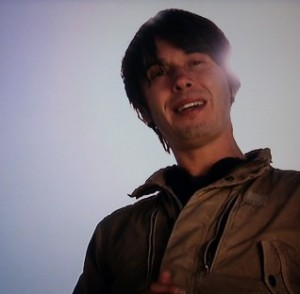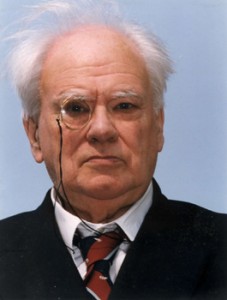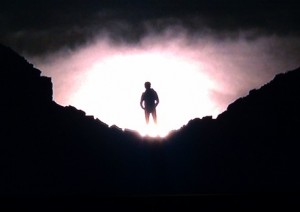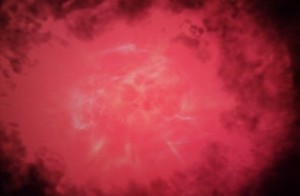Professor Brian Cox brings a fresh face to popular science. His new TV series “Wonders of the Universe” will only add to his growing popularity. There’s no question his first TV series “Wonders of the Solar System” paved the way; and the subsequent series “Stargazing Live” consolidated Cox in his position as a star [pun] of popular science. Suffice to say that science needs people like Cox, a look at his facebook or twitter pages will show the interest he’s stirred amongst everyday people. Don’t worry, in this post I’m going to talk physics not personalities, science not social networks 🙂
Last Sunday it seemed a torch was being passed. As “The Sky At Night” celebrated it’s 700th episode, over 54 years under the stewardship of the legendary Sir Patrick Moore; the pretty-boy of physics (myself excluded of course), Professor Brian Cox was beginning his new series “Wonders of the Universe”. The first episode is entitled simply, “Destiny”.
Cox shared some very interesting numbers with us and I’m going to list some of them here for your delectation:
- The Universe began about 13.7 billion years ago
- The Universe currently has over one hundred billion (100,000,000,000+) galaxies.
- Each galaxy contains hundreds of billions of stars
- A day on Earth is the 24 hours it takes our planet to rotate once on its axis
- Our months are based on the 29.5 days it takes the Moon to wax and wane across the night sky
- One year is 365.25 days it takes Earth to orbit once around the Sun (every four years we take the 0.25 days and add them to the end of February – leap year!)
- It takes our solar system about 250 million years to orbit once around our galaxy. My Aside: Our galaxy is sweetly named “The Milky Way”, and if you live in a city you’ve probably never seen it 🙁 Head away from the city lights one clear night and you’ll be amazed at the night sky 🙂
- There’ll be some more (big) numbers later…
Studying the stars is not a recent phenomenon, man has being doing it for thousands of years. Cox went to Chankillo in Peru, where 2500 years ago the inhabitants there built a solar calendar using rocks and knowledge of where the sunrise occurred throughout the year. But I have to correct Cox in one thing he says: “What a magnificent achievement, I mean, it’s probably one of our earliest attempts to measure the heavens“. No doubt it’s a magnificent achievement, but it’s not near the first. More than 5000 years ago the inhabitants in Ireland (yes I’m Irish :)) built structures (Cairns) based on the solar calendar. One example is Newgrange (3200 BC) based on the Winter Solstice, another example is Lough Crew (3200 BC) based on the Autumnal Equinox. We’ll forgive Cox that since he’s not an historian after all 🙂
Cox had to deal with some large numbers, after all he’s dealing with the whole universe and it’s entire lifetime. He rightly points out that some of these numbers are unimaginably large (more on this later). But he makes a decent stab at trying to ground these large numbers into something sensible by comparing them to long-term events as diverse as turtles laying eggs, an abandoned diamond-mining town, a decaying marooned ship, and a glacier.
Professor Cox talked about the Arrow of Time, and how the Second Law of Thermodynamics states that entropy is always increasing. You can think of low entropy as order (like a nice new car) and high entropy as disorder (a battered old car). I have to be a pedant and say that entropy doesn’t have to increase, entropy can remain the same and it can decrease. For example in biology, high entropy molecules are combined to make low entropy life forms. Another example, in physics, is the formation of planets and stars – gravity tends to reduce entropy. But the overall point Cox makes is that, in the long run, the Universe will tend towards a state of high entropy. So the next time your kids mess up your house, it’s not their fault, it’s the Second Law of Thermodynamics dictating that entropy must increase!
Now here’s a a name to note, GRB090423, it’s a faint red glow in the sky (if you have the right equipment) and it’s the afterglow of the explosive death of one of the first stars in the universe. The light reaching us now took 13 billion years to get here, which means the star died when the universe was just over 600 million years old. As Prof Cox said it’s the “oldest single object that we’ve ever seen”.
Now, to lighten things up a little. I noticed in the first series “Wonders of the Solar System” a lot of the time the director would take shots of Cox backlit by the Sun. This resulted in much squinting on my part as the Sun came into view and shone down the camera lens. That’s fair enough I suppose since the series is about the Solar System. But I had to laugh when I saw the same camera shot used several times in the first episode “Destiny” of the new series “Wonders of the Universe”. The more I looked at them, the more they began to look like Messianic shots. Oh, the irony! The photo at the top of this post is an example and this one is my favourite; well I suppose he was a rock-star back in the day 🙂
With that comic aside out of the way, lets turn to the end of Earth, our Solar System, and the Universe. Bummer! Earlier I said I’d get back to some really big numbers so here we go. Prof Cox describes some of these as “unimaginably large numbers“:
- In around one billion years Earth will be destroyed by the Sun
- In around six billion years the Sun will explode
- In around ten thousand trillion trillion trillion trillion trillion trillion trillion trillion years the Universe will be nothing more than a sea of photons. By my calculation that’s actually one Googol years. It’s not often you get to use the Googol number, if you don’t know how much it is – google it. Oh, the irony 🙂
- Cox also told us that “As a fraction of the lifespan of the universe … life, as we know it, is only possible for one thousandth of a billion billion billion billion billion billion billion billion billionth of a percent.” By my calculation, that means life is only possible for a period of one hundred trillion years (10^100 – 10^86 = 10^14).
Finally I’m going to just give you some great quotes from Prof Cox, which essentially map out a (rather bleak) future for Earth, our Solar system, and the Universe.
“As it [the Sun] begins to run out of fuel, it’s core will collapse, and the extra heat this generates will cause it’s outer layers to expand. In around a billion years time this will have a catastrophic effect on our fragile world. In 6 billion years our Sun will explode. The fate of the sun is the same as for all stars, one day they all must die and the cosmos will be plunged into eternal night.
As the age of starlight ends, all but the dimmest flicker of light in the universe will go out. The faint glow of white-dwarves will provide the only illumination in a dark and empty void, littered with dead stars and black holes. By this point the universe will be a hundred-trillion years old”.
“[Black dwarves are] White dwarves that have become so cold they barely emit any heat or light. Black dwarves are dark dense decaying balls of degenerate matter, little more than the ashes of stars. With the black dwarves gone, there won’t be a single atom of matter left. All that will remain of our once rich cosmos will be particles of light, and black holes. After an unimaginable length of time even the black holes will have evaporated and the universe will be nothing but a sea of photons gradually tending towards the same temperature … absolute zero”
“The story of the universe finally comes to an end. For the first time in its life, the universe will be permanent and unchanging. Entropy finally stops increasing because the cosmos cannot get any more disordered. Nothing happens, and it keeps not happening, forever. It’s what’s known as the heat-death of the universe. An era when the cosmos will remain vast and cold and desolate for the rest of time … the arrow of time has simply ceased to exist. It’s an inescapable fact of the universe written into the fundamental laws of physics, the entire cosmos will die.”
…more coming and wise (see what I did there!) when I review episode 2 of Wonders of the Universe. Please leave feedback or comments and let me know what you think.






Hi there,
I searched the internet with the purpose of finding out if there is scientific consensus about the nature of time and the fate of the Universe as presented in the programme. I’m not a physicist and didn’t know if there is. A good couple of years ago I attended a metaphysics course at university, where i learnt that the nature of time (if it’s an arrow or a circle or else) is a metaphysical subject, which, I suppose, should mean that there cannot be scientific consensus about it. Without my notes I can remember next to nothing about the course, and now I’m also not sure if the metaphysical nature of time implies anything about the fate of the Universe, which is some kind of prediction that scientists make a lot and successfully.
A few months ago I read a popular science article which pointed to the following publication:
Or may be it’s easier to Google the title: Radial motion into an Einstein–Rosen bridge
If I understand correctly this says that matter does not have to disappear from our universe, but could be the ‘building material’ for another one through/inside a black hole — like ours could have emerged. Is this idea, or others a bit less bleak than the one presented in the programme, perceived very unlikely to work?
To be honest it’s much the bleakness that bothers me, which is interesting provided that the finite nature of my own existence I have accepted. Oh the irony! But in the same time I suspect genuine uncertainty in the matter.
Best regards,
Tamas
Hi Tamas,
Time and space are studied in metaphysics, as well as physics; but the purpose is different.
Yes there are other theories about the lifecycle of the Universe, not everyone agrees with the lifecycle laid out in this episode of wonders.
One such theory is the “oscillating universe” theory which, briefly, proposes that the universe will collapse in on itself in an event called the “Big Crunch”, which can then give rise to another “Big Bang”; and so the cycle continues.
Another theory is what I used to call the “Polyverse”, but was subsequently coined the “Multiverse” and that’s how it’s commonly referred to. Amongst other things it proposes that every decision gives rise to a new separate ‘universe’ where each option is played out.
We do know from history that our view of the lifecycle of the universe is not constant, it changes as we understand more. So, while there is no consensus, even if there was consensus it does not guarantee correctness.
Regards,
Al
Pingback: Professor Brian Cox - Wonders of the Universe - Stardust - althinkingalthinking blog
(If i understood your argument correctly my reply is)
I think questioning the eventual end of the universe simply on the basis of it seeming gloomy is firstly wrong for obvious reasons, astronomy doesnt always have to be beautiful (as Brian Cox often says it is, which it is, but black holes are SCARY lol) and also not really that important because by this time, unimaginable as it is, Human and any life in the universe will have run its course, we will be long gone, and i think another 1000 years will be an amazing feat of man kind, let alone a trillion trillion trillion blah blah blah
Hi Jon,
You’re right in the sense there is probably no practical use in knowing the lifecycle of the universe. But it would be fascinating to know exactly how the universe came about and how it will end, if it ends at all.
According to Cox, Earth will be destroyed by the Sun in about 1 billion years. But will humans still exist at that time – at the current rate its hard to imagine we will. But who knows!
Why are we so intrigued about the begin and ends of things? It will be no concern of ours when the Sun falls to pieces, or the Universe, that the Universe is X number of years old is meaningless, better spending their money and time on what matters now – there is much in the solar system they do not know, despite confidently pretending otherwise.
And there’s so much we don’t even know about Earth – let alone the Solar system. We’ve barely scratched the surface of the oceans, new life-forms are being discovered all the time.
I was surprised at the meteorite containing amino-acids (in Wonders episode 2: Stardust), who knows what lurks under the oceans!
Pingback: A Possible Universe | Blog of The Imaginator
Exactly what I was looking for…. a re-cap of Brian Cox’s explanation of entropy and the universe constantly trying to un-build itself… I thought it was an amazing theory and one I will remember for the rest of my life – I will tell the story to my future kids and grandkids… (not just before bed though..!)
I find it fascinating that everything that there ever is/was/will be is all a concequance of an accident and our whole existance is just a by-product of nature tring to get back to nothingness…. we are just parasites feeding off other parasites in a universe in demolition.
It’s so hard to try to understand that EVERYTHING will eventually disappear… this keyboard, that porcelain cup, that paper clip…. that big dusty rock whizzing around earth… but when you drop in the timescales and the enormous explosions, you believe it.
Its almost enough to make you think ‘what’s the point in us being here at all?!’ because even if we do manage to avoid the burnout of earth by the expanding sun in a billion years, we will never out-run the universe.
So as we try to better our lives and our towns and cities, building bigger, stronger, more durable things for better qualities of life, nature is doing the complete opposite… fascinating!
Hi,
I have a bit of a strange question, but I’ll justify it by saying, despite an inquiring mind, I’ve never had much of a mathematical/scientific aptitude. 🙂
The quote from Brian Cox about the possibility of life as we know it in this universe being one thousandth of a billion, billion, billion, etc is fascinating, but I’d like to see it in decimal form if you can show it here. I know in the show he drew it in the sand, but it was hard to see properly. It would put it in perspective…
Thank you.
Claire
Hi Claire,
So as a fraction of the lifespan of the universe, life as we know it is possible for
0.000000000000000000000000000000000000000000
000000000000000000000000000000000000000001%
That brings new meaning to carpe diem, lol.
By my calculation that percentage amounts to about one hundred trillion years i.e. 100000000000000 years.
The current age of the universe is about 13.7 billion years, i.e. 13700000000 years.
Of course the more ‘immediate’ issue for us Earth dwellers is the destruction of our planet in about 1 billion i.e. 1000000000 years by the Sun.
Regards,
Al
Thank you! There were so many zeros that the number was off the page, but I get the idea. 🙂 Like I said, I’m not a mathematical whizz but I was guessing there’d be something like 78 zeros before the one?? It’s my ‘need to know the answer’ gene that tells me to find someone who actually knows what they’re talking about to confirm it! 🙂
That number makes you sorry you’ve wasted so much time in your life worrying about the small things when it was such a slim chance that we’d exist at all…Food for thought, indeed.
Thanks again.
Claire
I edited the post so all the zeroes should be visible now, but this might be easier to read:
0.
000000000
000000000
000000000
000000000
000000000
000000000
000000000
000000000
000000000
001%
There are 83 zeroes, but you can add two more zeroes for the percentage (1/100th).
hth,
Al
is there a way to write that percentage in a shorter form? or as a fraction in a shorter form? I’m no mathematician.. can you do a ‘to the power of’?? or anything?
0.00000000000000000000000000000000000000000000000000000000000000000000000
000000000001%
What is the history of the shipwrecked boat which Professor Cox used to demonstrate Entropy? I heard him say the date, it was the day my father was born in 1909. I would be interested to record this event.
It was the Edward Bohlen, an ocean going steamer out of Germany, ferrying passengers and cargo between Europe and Namibia; she ran aground in thick fog off Namibia’s Skeleton Coast on 5 September 1909. Information from Wikipedea Shipwrecks 1909.
You don’t seem to understand the second law of thermodynamics. In a CLOSED SYSTEM entropy increases.
The biological example is a typical creationist misunderstanding of this law. The rearrangement of atoms in order, creating biological entities on earth does indeed reduce the entropy of those atoms on the planet. But due to the large hot yellow thing in the sky delivering vast quantities of energy to the planet, the earth is not a closed system.
The cosmological example is flawed for the same reason. Order in a very tiny part of the galaxy/universe does not reflect decreased entropy in the whole system.
Hi Richard, thanks for your response.
The second law of thermodynamics states that in a cyclic system the entropy either remains the same or increases. I highlighted a couple of examples where entropy decreases (lest readers think it was totally a one way street in every part of the universe all of the time), and I did point out: “But the overall point Cox makes is that, in the long run, the Universe will tend towards a state of high entropy”.
It’s also worth noting that:
Cox explained the heat-death theory of the universe, but there are other theories such as the Big Crunch, and there are Cyclic theories of the universe. What happens entropy leading up to a Big Crunch isn’t settled, nor is what happens entropy when matter falls into a black-hole.
So it’s possible in the oscillating universe, that as the universe tends towards a big-crunch overall entropy will decrease (in that phase of the lifecycle). If the universe is indeed cyclical it can be the case that overall entropy remains constant (in accordance with the second law of thermodynamics) for a given point in each period of the lifecycle; ditto for a single cycle of the Big Bang – Big Crunch lifecycle.
It’s also unknown how entropy is affected by theories such as the multiverse theory, or phase-time.
Our voyage of scientific discovery has taught us that theories are written in pencil, not carved in stone or tablet.
The second law of thermodynamics says that the total entropy of the universe can never decrease. Therefore, the universe tends toward High Entropy – not low Entropy!
Hi Jfraysse,
Thanks for pointing out the typo, it’s been corrected 🙂
Al
Hi,
Great to read everyone’s comments, but I have question about something the Prof said in one of his programmes. It might have been the Solar system one, but I’m not sure! It was something about the universe and everything in it was made of, and I quote, “Stuff”. Any ideas? Interesting article by the way, and I’d noticed the messianic backlighting too 🙂 He was endearingly self-deprecating on one of the Stargazing Live episodes though, when he referred to his having to “point whistfully at the sky” at least once every appearance…
Could not the speed of photons be actually billions faster ?
The apparent slow speed when compared to the size of the universe is strange .
That slow speed could be caused by time within this universe is SLOWED DOWN by a factor of more than a BILLION or even a TRILLION
Outside this it could all be a flash followed by a smoldering ember that gradually goes cold like a firer cracker
I deeply suspect our perception of time is NOTHING like that outside this universe
If the light from the explosion of star GRB090423 took 13 billion years to reach us, the star must have been 13 billion light years away at the time the light set off to travel towards us. We wouldn’t have been that far away from the star when the universe was only 600 million years old surely. Did the early universe expand at a rate faster than the speed of light? I have never understood this concept. How far away would this star be today if it still existed? I believe the universe is expanding, but it still has a finite measurement. What is the current size of the universe?
I was just speaking to my friends about “how long the sun has left” and I was telling them it’s 6billion years.. Then one of the girls said but how do we know this?? “How do we know its not got 100years left of fuel left in it”…
So I was wondering how do we know that??
And which version of “billion” is used?
1 000 000 000 000
or the cheaper version
1 000 000 000
an exception to the arrow of time
if someone dies but is resuscitated does this break the law of the arrow of time or does that persons arrow of time restart from the point?
WoT?
No mention of
Enthalpy?